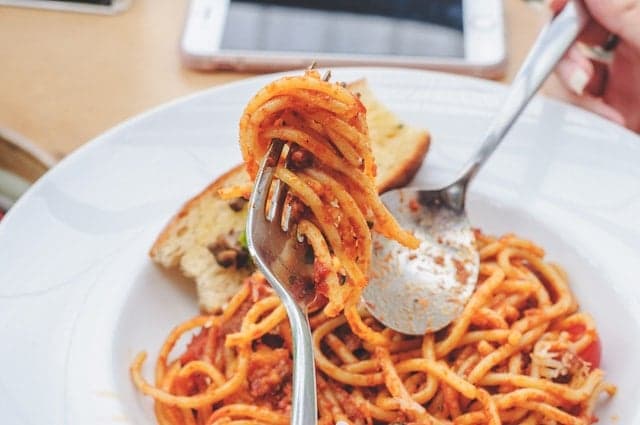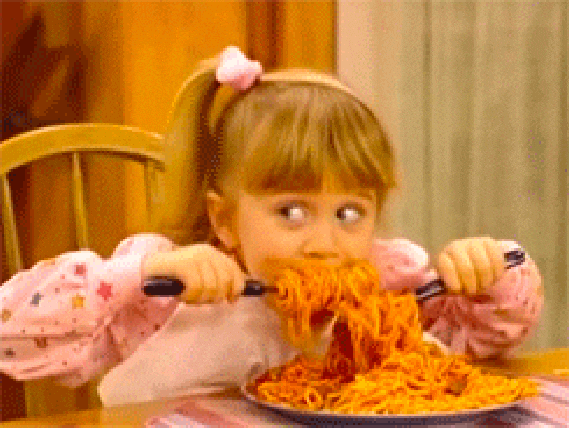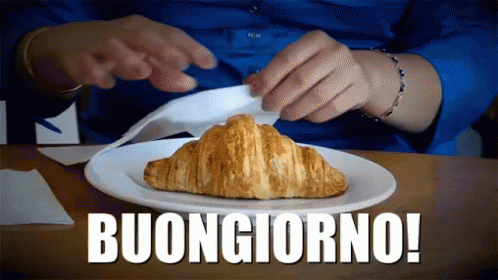How do Italians eat spaghetti? The Local answers Google’s questions

How do Italians eat spaghetti? What do Italians eat for breakfast? In a series of articles, The Local answers some of the most common questions that appear when you start typing questions with "Italy" or "Italians" into the Google search engine.
In this piece, we answer some of the most commonly googled questions about Italian food culture.
Read on to find out how Italians drink coffee, whether you need a fork to eat pizza in Italy, and whether you should tip in Italian restaurants...
How do Italians eat spaghetti?
According to the blog Roma gourmet, spaghetti or any other kind of long pasta should be eaten with a fork, and definitely not cut up into more manageable pieces with a knife.
In a sharp rejection of the technique demonstrated by Saoirse Ronan in the film Brooklyn, where Ronan’s character eats spaghetti with the Italian-American family of her love interest Tony, the blog's authors say you also shouldn’t need the assistance of a spoon.
READ ALSO: Why is Italy called Italy?
Instead, if you want to eat spaghetti like an Italian, you should twirl your fork clockwise against your plate at an angle, picking up just a few strands to achieve a tidy ‘moderate bite’ that avoids leaving 'slobbering threads' hanging over the edge. Appetising.

What do Italians eat for breakfast?
As with all questions about food in Italy, the answer varies from region to region.
But as a general rule, Italians definitely tend to err on the sweet side for breakfast.
A common breakfast is a cornetto (if you’re in the centre-south) or brioche (if you’re in the north) that resembles a French croissant, but is much sweeter and denser, and is dusted with icing sugar and/or brushed with a glaze on top.
READ ALSO: 15 things you’ll probably never get used to about living in Italy
The more indulgent variations are often filled with honey, jam, chocolate spread, or an almond frangipane or pistachio cream. Other popular breakfast options are crostata jam tarts or ciambelle donuts.
Sicilians will go one step further and have gelato in a brioche bun to start their day on a real sugar high.

Whichever region you're in, you can't have breakfast in Italy without a cappuccino; which brings us to our next question:
How do Italians drink coffee?
This question is deserving of a detailed article in its own right - but we can get a few basics out the way here.
Tourists and new arrivals to Italy are often dismayed to learn that it's a faux pas to order a cappuccino in Italy after breakfast time.
READ ALSO: Seven surprising Italian food rules foreigners fall foul of
That's because cappuccini mostly consist of milk, and so are considered a breakfast drink - a bit like how it would seem strange to order bowl of cereal after breakfast is over.
From this point in the day onwards, you should order an espresso or a caffe macchiato. Most Italians will knock back a quick shot at the coffee bar after lunch to keep their energy levels up.

After a dinner out, the waiter will usually offer you an espresso at the end to round off your meal. It's common to have this with a shot of amaro liqueur or grappa, or in some southern regions, sweet limoncello, as an ammazzacaffè.
That all said, if you fancy a cappuccino beyond breakfast time, go ahead: these days most baristas will happily comply, understanding you're a clueless foreigner who just has odd food habits.
Do Italians eat pizza with a fork?
Yes! Going to a pizzeria in Italy isn't a fast food experience, but a nice night out.
Because it takes time and a lot of fuel to get a pizza oven up to the very high temperatures needed for that stretchy, elastic dough, many restaurants outside of tourist areas will only serve pizza in the evenings, judging that opening for a reduced lunch crowd isn't worth it.
If you're going for a sit down meal in the evening, it's not really a finger food affair, and you'd look a bit uncouth tearing into your pizza with your bare hands.
READ ALSO: How to spot the Italian restaurants to avoid
However, if you're ordering a couple of individual slices of pizza from a bakery to eat al volo, or on the fly, then it's expected that you'll eat with your fingers.
Similarly, if you're going to one of the famous Naples establishments where most of the pizza is ordered to take away through a hole in the wall, it's fine to eat by hand (after all, how are you going to use cutlery when you're standing in the street).
But if you're sat down in a restaurant, it's generally expected you'll use your knife and fork.
Do Italians tip?
A little – but Italy doesn’t have the tipping culture of the US, where a waiter might be dependant on your tip to make a decent living.
Most Italian restaurants will include a coperto (cover charge) of about two euros per person in your bill, so you’re already paying a bit extra for service.
If you really enjoyed your meal or want to thank your waiter, it’s a nice gesture of goodwill to leave another one or two euros on the table; and leaving anything more than this will definitely be appreciated.
But you won’t cause offence if you don't leave anything, and it's not expected that you will.
Comments
See Also
In this piece, we answer some of the most commonly googled questions about Italian food culture.
Read on to find out how Italians drink coffee, whether you need a fork to eat pizza in Italy, and whether you should tip in Italian restaurants...
How do Italians eat spaghetti?
According to the blog Roma gourmet, spaghetti or any other kind of long pasta should be eaten with a fork, and definitely not cut up into more manageable pieces with a knife.
In a sharp rejection of the technique demonstrated by Saoirse Ronan in the film Brooklyn, where Ronan’s character eats spaghetti with the Italian-American family of her love interest Tony, the blog's authors say you also shouldn’t need the assistance of a spoon.
READ ALSO: Why is Italy called Italy?
Instead, if you want to eat spaghetti like an Italian, you should twirl your fork clockwise against your plate at an angle, picking up just a few strands to achieve a tidy ‘moderate bite’ that avoids leaving 'slobbering threads' hanging over the edge. Appetising.

What do Italians eat for breakfast?
As with all questions about food in Italy, the answer varies from region to region.
But as a general rule, Italians definitely tend to err on the sweet side for breakfast.
A common breakfast is a cornetto (if you’re in the centre-south) or brioche (if you’re in the north) that resembles a French croissant, but is much sweeter and denser, and is dusted with icing sugar and/or brushed with a glaze on top.
READ ALSO: 15 things you’ll probably never get used to about living in Italy
The more indulgent variations are often filled with honey, jam, chocolate spread, or an almond frangipane or pistachio cream. Other popular breakfast options are crostata jam tarts or ciambelle donuts.
Sicilians will go one step further and have gelato in a brioche bun to start their day on a real sugar high.

Whichever region you're in, you can't have breakfast in Italy without a cappuccino; which brings us to our next question:
How do Italians drink coffee?
This question is deserving of a detailed article in its own right - but we can get a few basics out the way here.
Tourists and new arrivals to Italy are often dismayed to learn that it's a faux pas to order a cappuccino in Italy after breakfast time.
READ ALSO: Seven surprising Italian food rules foreigners fall foul of
That's because cappuccini mostly consist of milk, and so are considered a breakfast drink - a bit like how it would seem strange to order bowl of cereal after breakfast is over.
From this point in the day onwards, you should order an espresso or a caffe macchiato. Most Italians will knock back a quick shot at the coffee bar after lunch to keep their energy levels up.

After a dinner out, the waiter will usually offer you an espresso at the end to round off your meal. It's common to have this with a shot of amaro liqueur or grappa, or in some southern regions, sweet limoncello, as an ammazzacaffè.
That all said, if you fancy a cappuccino beyond breakfast time, go ahead: these days most baristas will happily comply, understanding you're a clueless foreigner who just has odd food habits.
Do Italians eat pizza with a fork?
Yes! Going to a pizzeria in Italy isn't a fast food experience, but a nice night out.
Because it takes time and a lot of fuel to get a pizza oven up to the very high temperatures needed for that stretchy, elastic dough, many restaurants outside of tourist areas will only serve pizza in the evenings, judging that opening for a reduced lunch crowd isn't worth it.
If you're going for a sit down meal in the evening, it's not really a finger food affair, and you'd look a bit uncouth tearing into your pizza with your bare hands.
READ ALSO: How to spot the Italian restaurants to avoid
However, if you're ordering a couple of individual slices of pizza from a bakery to eat al volo, or on the fly, then it's expected that you'll eat with your fingers.
Similarly, if you're going to one of the famous Naples establishments where most of the pizza is ordered to take away through a hole in the wall, it's fine to eat by hand (after all, how are you going to use cutlery when you're standing in the street).
But if you're sat down in a restaurant, it's generally expected you'll use your knife and fork.
Do Italians tip?
A little – but Italy doesn’t have the tipping culture of the US, where a waiter might be dependant on your tip to make a decent living.
Most Italian restaurants will include a coperto (cover charge) of about two euros per person in your bill, so you’re already paying a bit extra for service.
If you really enjoyed your meal or want to thank your waiter, it’s a nice gesture of goodwill to leave another one or two euros on the table; and leaving anything more than this will definitely be appreciated.
But you won’t cause offence if you don't leave anything, and it's not expected that you will.
Join the conversation in our comments section below. Share your own views and experience and if you have a question or suggestion for our journalists then email us at [email protected].
Please keep comments civil, constructive and on topic – and make sure to read our terms of use before getting involved.
Please log in here to leave a comment.